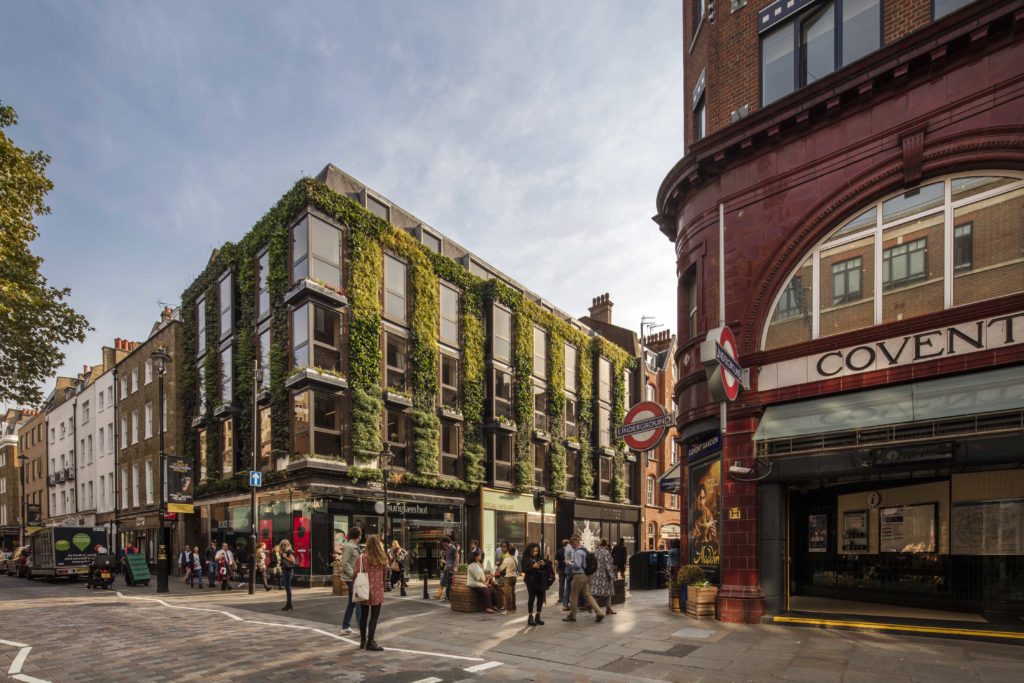Scroll Down
Scroll Down
Scroll Down
Covent Garden
Covent Garden Market served as a fruit, vegetable and flower market from 1654 until 1974. The new appearance of Regal House reflects the heritage of this site. At the same time, it serves as a contemporary entrance to the area, highlighting the potential for biodiversity in urban developments.
The colourful plant palette chosen reflects the path of the sun during the day. The north-facing side is more peaceful, while the west-facing side bursts into bloom in the summer. At night, this illuminated vertical garden draws the attention of pedestrians en route to nearby theatres or bars, and it has become an iconic location for photos, as well as a popular meeting spot.

Still, its attractive appearance is not its most important attribute. Its greatest benefits are environmental:
The living wall supports biodiversity, air purification, temperature reduction and rainwater retention.
Biodiversity
Plants were selected to support increased biodiversity in the area. New hiding places for birds were positioned between plants carefully selected to provide nectar for bees and various other insect species. Current urban developments urgently need to attract pollinators to their parks and gardens and the whole city should be understood as an active urban biotope.
Air Purification
Greener streets mean cleaner air. According to a WHO study, air pollution causes 5.5 million premature deaths each year. Air pollution collects between buildings in densely populated areas and many academic studies support the positive impact of incorporating plants in architecture. The collection of toxins, gases and particulate matter by plants introduces a variety of biogenic regulation processes. The three most important of these are sedimentation, impaction and Brownian motion and they all help to improve the quality of the air we breathe.
Temperature
It is anticipated that London’s climate could resemble that of the South of France by 2050 due to climate change. European cities are unprepared for these kinds of changes. Hard street surfaces accumulate heat, leading to overheating. Plants, trees and living walls reduce temperature thanks to a process known as evapotranspiration. As the name suggests, this is a combination of plant surface water release (evaporation) and the humidity released from plant cells (transpiration), and it takes place even on the warmest of days. The introduction of green areas leads to the reduction of urban heat islands, while natural thermal regulation improves the micro climate of our streets. This can also reduce the consumption of electric energy, as there is less need for air conditioning.
Water
Rainwater collection is part of the design. While the rainwater reservoir cannot provide for all of the building’s year-round needs, it helps to irrigate the green wall via a remotely operated hydroponic irrigation system and contributes to reducing water consumption.
The Mission
The design of this facade was not the work of a single individual. It is the result of a collaboration between botanical experts, technologists and additional specialists at Biotecture Ltd. This project would never have happened without our client and the initiator of the idea, Capital & Counties. We all aimed to deliver the project’s environmental message. Our intention was to improve the quality of Londoners’ lives through sophisticated and biodiverse urban development.
Summary:
- over 8,000 plants representing 21 different varieties
- approximately 200m2 of living wall facing north and west directions
- located opposite Covent Garden Station in London
- developed with living wall company Biotecture Ltd for CapCo London

